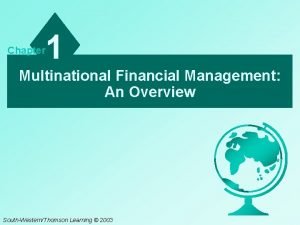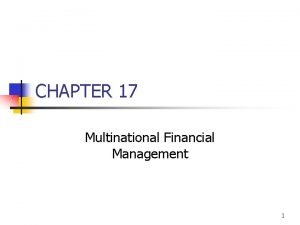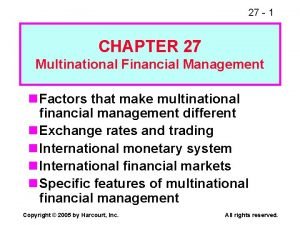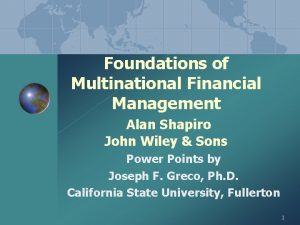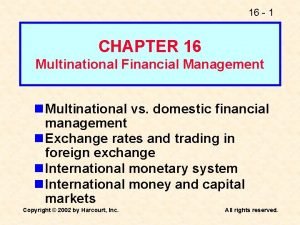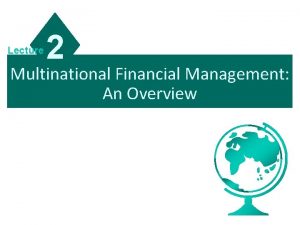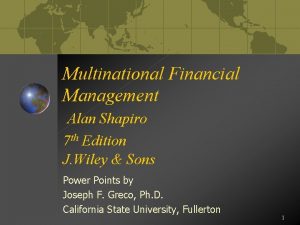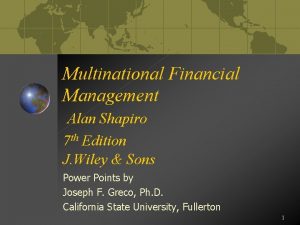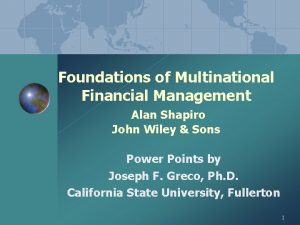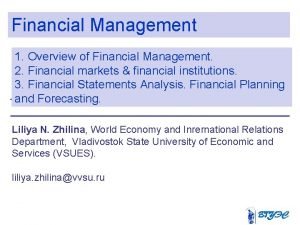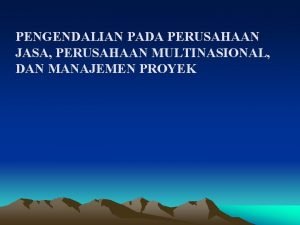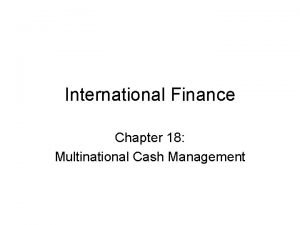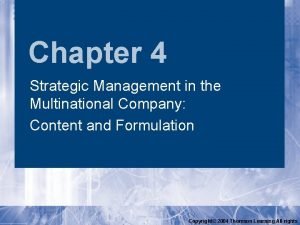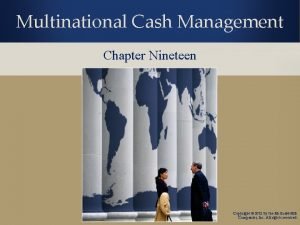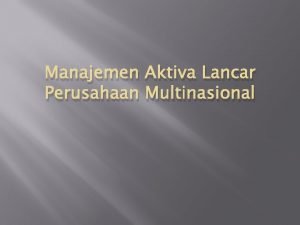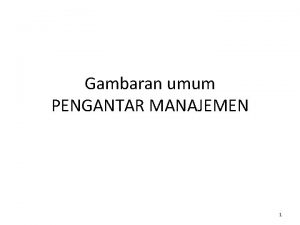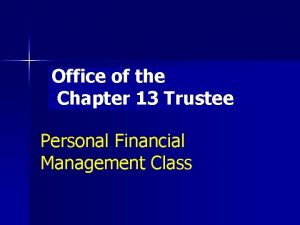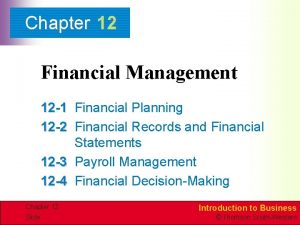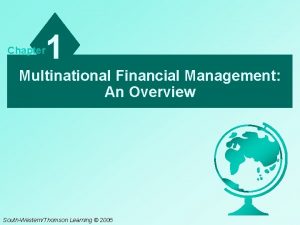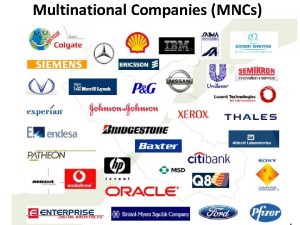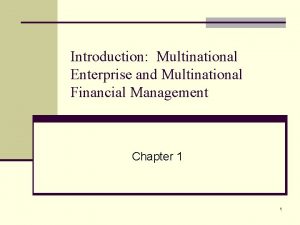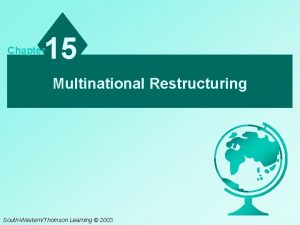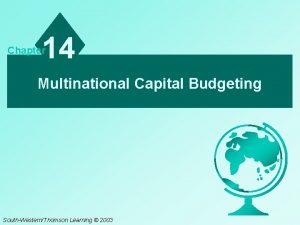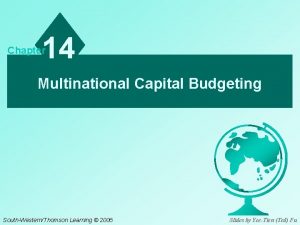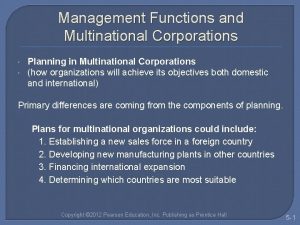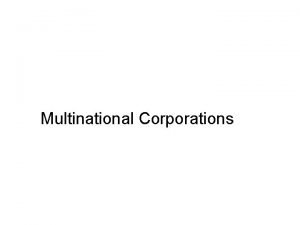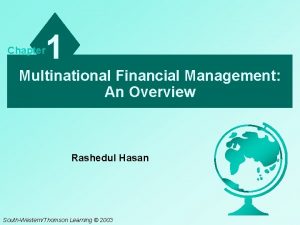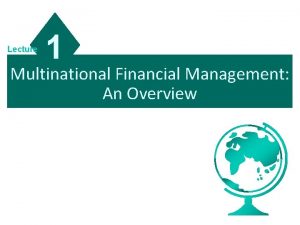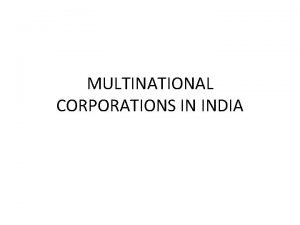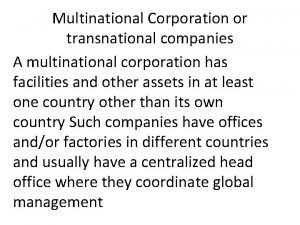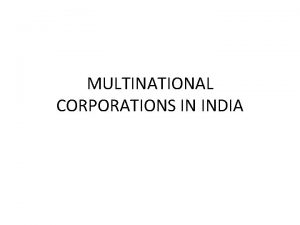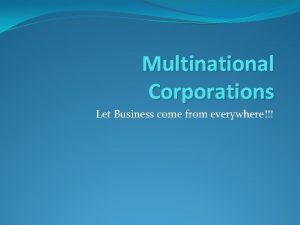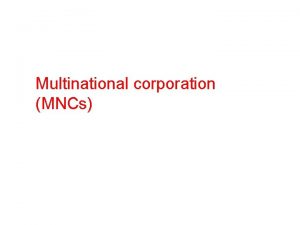Chapter 1 Multinational Financial Management An Overview SouthWesternThomson


































- Slides: 34

Chapter 1 Multinational Financial Management: An Overview South-Western/Thomson Learning © 2003

Chapter Objectives • To identify the main goal of the multinational corporation (MNC) and conflicts with that goal; (多國籍企業目標) • To describe the key theories that justify international business; (形成多國籍企業理論) • To explain the common methods used to conduct international business. (經營方式) C 1 - 2

Goal of the MNC • The commonly accepted goal of an MNC is to maximize shareholder wealth. (極大化股 東財富) • We will focus on MNCs that are based in the United States and that wholly own their foreign subsidiaries. C 1 - 3

Conflicts Against the MNC Goal • For corporations with shareholders who differ from their managers, a conflict of goals can exist - the agency problem. (代理問題) • Agency costs(代理成本) are normally larger for MNCs than for purely domestic firms. 理由如下: ¤ The sheer size of the MNC. ¤ The scattering of distant subsidiaries. ¤ The culture of foreign managers. ¤ Subsidiary value versus overall MNC value. C 1 - 4

Impact of Management Control • The magnitude of agency costs can vary with the management style of the MNC. • A centralized(集權式) management style reduces agency costs. However, a decentralized(分權式) style gives more control to those managers who are closer to the subsidiary’s operations and environment. C 1 - 5

Centralized Multinational Financial Management for an MNC with two subsidiaries, A and B Cash Management at A Inventory and Accounts Receivable Management at A Financing at A Capital Expenditures at A Financial Managers of Parent Cash Management at B Inventory and Accounts Receivable Management at B Financing at B Capital Expenditures at B C 1 - 6

Decentralized Multinational Financial Management for an MNC with two subsidiaries, A and B Cash Management at A Financial Managers of A Inventory and Accounts Receivable Management at A Financing at A Capital Expenditures at A Financial Managers of B Cash Management at B Inventory and Accounts Receivable Management at B Financing at B Capital Expenditures at B C 1 - 7

Impact of Management Control • Some MNCs attempt to strike a balance they allow subsidiary managers to make the key decisions for their respective operations, but the decisions are monitored by the parent’s management. C 1 - 8

Impact of Management Control • Electronic networks make it easier for the parent to monitor the actions and performance of foreign subsidiaries. • For example, corporate intranet or internet email facilitates communication. Financial reports and other documents can be sent electronically too. C 1 - 9

Impact of Corporate Control • Various forms of corporate control can reduce agency costs. (降低代理成本的方法) ¤ Stock compensation for board members and executives. (給與股票獎勵) ¤ The threat of a hostile takeover. (敵意接管) ¤ Monitoring and intervention by large shareholders. (法人機構ex基金經理人監督) C 1 - 10

Constraints Interfering with the MNC’s Goal • As MNC managers attempt to maximize their firm’s value, they may be confronted with various constraints. (面臨的限制) ¤ Environmental constraints(廢棄物污染管制) Regulatory constraints. (管制措施: 稅. 盈餘匯 回. 外匯管制等)等 ¤ Ethical constraints. (賄賂在國家間之認定標 準不一) ¤ C 1 - 11

Theories of International Business Why are firms motivated to expand their business internationally? Theory of Comparative Advantage(比較利益) ¤ Specialization by countries can increase production efficiency. ¤ Ex: 技術優勢 vs 廉價勞 ¤ 無法運輸或移轉 ¤ 各自從事有比較利益的生產 C 1 - 12

Theories of International Business Why are firms motivated to expand their business internationally? Imperfect Markets Theory(不完全市場理論) ¤ The markets for the various resources used in production are “imperfect. ” ¤ 生產要素無法移動 ¤ 生產要素的移轉有成本與限制 ¤ 公司到國外尋找機會 C 1 - 13

Theories of International Business Why are firms motivated to expand their business internationally? Product Cycle Theory(產品生命週期理論) ¤ As a firm matures, it may recognize additional opportunities outside its home country. ¤ 國內生產 出口 海外生產(降低成本) ¤ 差異化產品或產品消失由於喪失競爭優勢 C 1 - 14

The International Product Life Cycle Firm creates product to accommodate local demand. a. Firm differentiates product from competitors and/or expands product line in foreign country. Firm exports product to accommodate foreign demand. or b. Firm’s foreign business declines as its competitive advantages are eliminated. Firm establishes foreign subsidiary to establish presence in foreign country and possibly to reduce costs. C 1 - 15

International Business Methods There are several methods by which firms can conduct international business. • International trade(國際貿易) is a relatively conservative approach involving exporting and/or importing. ¤ The internet facilitates international trade by enabling firms to advertise and manage orders through their websites. C 1 - 16

International Business Methods • Licensing(特許或專利) allows a firm to provide its technology in exchange for fees or some other benefits. • Franchising(授權) obligates a firm to provide a specialized sales or service strategy, support assistance, and possibly an initial investment in the franchise in exchange for periodic fees. C 1 - 17

International Business Methods • Firms may also penetrate foreign markets • by engaging in a joint venture(合資) (joint ownership and operation) with firms that reside in those markets. Acquisitions of existing operations(收購海 外公司) in foreign countries allow firms to quickly gain control over foreign operations as well as a share of the foreign market. C 1 - 18

International Business Methods • Firms can also penetrate foreign markets by establishing new foreign subsidiaries. • In general, any method of conducting business that requires a direct investment in foreign operations is referred to as a direct foreign investment (DFI). (直接投資) • The optimal international business method may depend on the characteristics of the MNC. C 1 - 19

Degree of International Business by MNCs C 1 - 20

International Opportunities • Investment opportunities - The marginal return on projects for an MNC is above that of a purely domestic firm because of the expanded opportunity set of possible projects from which to select. • Financing opportunities - An MNC is also able to obtain capital funding at a lower cost due to its larger opportunity set of funding sources around the world. C 1 - 21

International Opportunities Cost-benefit Evaluation for Purely Domestic Firms versus MNCs Marginal Return on Projects Marginal Cost of Capital Purely Domestic Firm Investment Opportunities MNC Purely Domestic Firm Financing Opportunities Appropriate Size for Purely Domestic Firm X Y Appropriate Size for MNC Asset Level of Firm C 1 - 22

International Opportunities • Opportunities in Europe The Single European Act of 1987. ¤ The removal of the Berlin Wall in 1989. ¤ The inception of the euro in 1999. ¤ • Opportunities in Latin America The North American Free Trade Agreement (NAFTA) of 1993. ¤ The General Agreement on Tariffs and Trade (GATT) accord. ¤ C 1 - 23

International Opportunities • Opportunities in Asia The reduction of investment restrictions by many Asian countries during the 1990 s. ¤ China’s potential for growth. ¤ The Asian economic crisis in 1997 -1998. ¤ C 1 - 24

Exposure to International Risk International business usually increases an MNC’s exposure to: exchange rate movements ¤ Exchange rate fluctuations affect cash flows and foreign demand. foreign economies ¤ Economic conditions affect demand. political risk ¤ Political actions affect cash flows. C 1 - 25

Exposure to International Risk U. S. Firm’s Cost of Obtaining £ 100, 000 2001 C 1 - 26

Overview of an MNC’s Cash Flows Profile A: MNCs focused on International Trade U. S. based MNC Payments for products U. S. Customers Payments for supplies U. S. Businesses Payments for exports Foreign Importers Payments for imports Foreign Exporters C 1 - 27

Overview of an MNC’s Cash Flows Profile B: MNCs focused on International Trade and International Arrangements U. S. based MNC Payments for products U. S. Customers Payments for supplies U. S. Businesses Payments for exports Foreign Importers Payments for imports Foreign Exporters Fees for services Costs of services Foreign Firms C 1 - 28

Overview of an MNC’s Cash Flows Profile C: MNCs focused on International Trade, International Arrangements, and Direct Foreign Investment Payments for products Payments for supplies U. S. based MNC Payments for exports Payments for imports U. S. Customers U. S. Businesses Foreign Importers Foreign Exporters Fees for services Costs of services Foreign Firms Funds remitted Funds invested Foreign Subsidiaries C 1 - 29

Managing for Value • Like domestic projects, foreign projects involve an investment decision and a financing decision. • When managers make multinational finance decisions that maximize the overall present value of future cash flows, they maximize the firm’s value, and hence shareholder wealth. C 1 - 30

Valuation Model for an MNC • An MNC’s financial decisions include how much business to conduct in each country and how much financing to obtain in each currency. • Its financial decisions determine its exposure to the international environment. C 1 - 31

How Chapters Relate to Valuation Exchange Rate Behavior (Chapters 6 -8) Background on International Financial Markets (Chapters 2 -5) Long-Term Investment and Financing Decisions (Chapters 13 -18) Short-Term Investment and Financing Decisions (Chapters 19 -21) Exchange Rate Risk Management (Chapters 9 -12) Risk and Return of MNC Value and Stock Price of MNC

Chapter Review • Goal of the MNC Conflicts Against the MNC Goal ¤ Impact of Management Control ¤ Impact of Corporate Control ¤ Constraints Interfering with the MNC’s Goal ¤ • Theories of International Business Theory of Comparative Advantage ¤ Imperfect Markets Theory ¤ Product Cycle Theory ¤ C 1 - 33

Chapter Review • International Business Methods ¤ ¤ ¤ International Trade Licensing Franchising Joint Ventures Acquisitions of Existing Operations Establishing New Foreign Subsidiaries C 1 - 34
 Centralized multinational financial management
Centralized multinational financial management Chapter 1 an overview of financial management
Chapter 1 an overview of financial management Multinational financial management requires that
Multinational financial management requires that Multinational financial management requires that
Multinational financial management requires that Multinational financial management shapiro
Multinational financial management shapiro Multinational vs domestic financial management
Multinational vs domestic financial management Multinational financial management definition
Multinational financial management definition Multinational financial management requires that
Multinational financial management requires that Multinational financial management definition
Multinational financial management definition Multinational financial management shapiro
Multinational financial management shapiro Overview of financial management
Overview of financial management Overview of financial management
Overview of financial management Chapter 2 an overview of the financial system
Chapter 2 an overview of the financial system Chapter 1 overview of financial statement analysis
Chapter 1 overview of financial statement analysis Karakteristik perusahaan multinasional
Karakteristik perusahaan multinasional What is multinational finance
What is multinational finance Multinational netting
Multinational netting Strategic management in multinational companies
Strategic management in multinational companies Multinational management is
Multinational management is Multinational cash management
Multinational cash management Multinational cash management
Multinational cash management Web content management tools capabilities
Web content management tools capabilities Introduction of hrm
Introduction of hrm Project management topics
Project management topics Gym management system erd
Gym management system erd Rtim wave 2020
Rtim wave 2020 Management overview
Management overview Peta konsep manajemen ekonomi
Peta konsep manajemen ekonomi Financial management chapter 8 risk and return
Financial management chapter 8 risk and return Chapter 20 patient collections and financial management
Chapter 20 patient collections and financial management Chapter 13 personal financial management course
Chapter 13 personal financial management course Chapter 12 money management strategy answers
Chapter 12 money management strategy answers Chapter 16 money management and financial planning
Chapter 16 money management and financial planning What are some characteristics of a wise money manager
What are some characteristics of a wise money manager Chapter 9 financial management
Chapter 9 financial management
